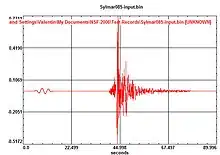Seismogram
A seismogram is a record of an earthquake induced motion at a measuring station as a function of time. Seismograms are usually taken by seismometers. Seisometers record motions in three cartesian axes (x, y, and z), with the z axis perpendicular to the Earth's surface and the x- and y- axes parallel to the surface.

Seismogram of Sylmar085 earthquake in fractions of gravity acceleration, UCSD.
Historically, seismograms were recorded on paper attached to rotating drums. Some used pens on ordinary paper. Others used light beams to expose photosensitive paper. Today, almost all seismograms are recorded digitally to make analysis by computer easier. Seismograms are very important for measuring earthquakes using the Richter scale.
Other websites
- An example seismogram Archived 2008-05-18 at the Wayback Machine
- REV, the Rapid Earthquake Viewer Archived 2006-01-12 at the Wayback Machine Seismograms recorded around the world from recent earthquakes (weeks old) as well as larger earthquakes from the past.
This article is issued from Wikipedia. The text is licensed under Creative Commons - Attribution - Sharealike. Additional terms may apply for the media files.